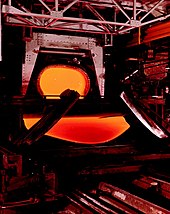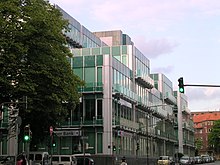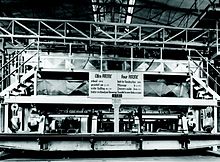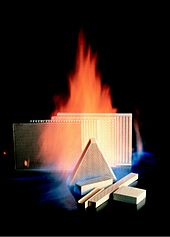Compagnie de Saint-Gobain
| Compagnie de Saint-Gobain | |
|---|---|
| legal form | Société anonyme |
| ISIN | FR0000125007 |
| founding | 1665 |
| Seat |
Courbevoie , France |
| management | Pierre-André de Chalendar ( CEO ) |
| Number of employees | 179,000 (2018) |
| sales | 40.8 billion euros (2017) |
| Branch | Conglomerate |
| Website | www.saint-gobain.com |
The Compagnie de Saint-Gobain is a listed French industrial group. The companies united under one roof employed more than 179,000 people in 2018 with an annual turnover of around 41 billion euros. Founded in 1665, Saint-Gobain is one of the oldest companies in the world and is represented in 67 countries around the world. The group of companies plays a leading role in flat glass , building materials , industrial ceramics , high-performance plastics and in the building materials trade; for a number of products from these areas even as a world market leader or as a European market leader. Its activities are divided into three main areas: innovative materials, building products and building trade.
organization
legal form
The parent company is a listed stock corporation . The share capital consists of more than 561 million shares. The investment company Wendel Investissement holds 11.7% of the capital.
Around 1200 individual companies are consolidated under the umbrella of the parent company . Saint-Gobain is a matrix organization . It is divided into general delegations and main divisions below the general management .
In Germany , Austria and the Benelux countries, Saint-Gobain is represented by the General Delegation for Central Europe based in Aachen . It is a peculiarity in that it is not an independent company, but rather a branch (permanent establishment) of the French parent company.
management
- Pierre-André de Chalendar, CEO ( Président-Directeur Général ) since spring 2007
- Claude Imauven, Chief Operating Officer
Senior Vice Presidents:
- Benoît Bazin
- John Crowe
- Peter Hindle
- Claire Pedini
- Jean-François Phelizon
Corporate Secretary:
- Antoine Vignial
General Delegate for Central Europe:
- Benoit d'Iribarne
history
Creation of the company in the age of mercantilism
Under King Louis XIV , his finance minister, Jean-Baptiste Colbert, was commissioned to found a Compagnie des Glaces in Paris. This was the hour of birth of the Manufacture Royale des glaces de Miroirs (royal mirror glass manufactory ) in the Faubourg Saint-Antoine district of Paris . Like many other companies that came into being at that time, it was an element of the centrally controlled economic policy of France in the 17th century. Following the mercantilist production theory prevailing at the time , the goods were manufactured in such companies in a precisely defined manner and quality and in production based on the division of labor, in contrast to the previously prevailing artisanal production method . Although the market and production were regulated by the state, entrepreneurship was in private hands. The young company's first major order was glass production for the hall of mirrors of the royal palace in Versailles .
After several reorganizations and renaming, the company operated under the name Compagnie des Grandes Glaces . In 1688 it was granted a state monopoly on the production of flat glass of all dimensions from 60 inches × 40 inches (1.56 m × 1.04 m) and up. In 1692 production was relocated to the village of Saint-Gobain in Picardy in northern France. In the following years further production facilities were added. The new locations served as namesake for the new company : Manufactures des Glaces et des Produits Chimiques de St. Gobain, Chauny et Cirey à Paris .
After Colbert's death, competing companies were admitted. After the loss of the monopoly, the company initially ran into economic difficulties. However, it was able to regain a position of supremacy on its own: Louis Lucas de Nehou : smeltery director at Saint-Gobain, developed a new process for the production of flat glass from 1688 , with which it can be produced in better quality, in larger quantities and in larger dimensions let. In this so-called table rolling process, the molten glass is poured onto level casting tables, then rolled smooth with heavy rollers and finally ground with sand. Before that, flat glass was mostly obtained by heating, cutting and rolling cylindrical glass. The new casting process was ready for the market around 1691. With this, Saint-Gobain gradually displaced the previously predominant Venetian glass production from the European market. Nehou's method was continuously improved over time, but in principle remained the standard method for the manufacture of flat glass until the 19th century.
In the 18th century, Saint-Gobain still benefited from state privileges. The French Revolution marked the final farewell to this economy: On August 4, 1789, the National Assembly resolved to abolish the system of privileges characteristic of the Bourbon monarchy . With the code de commerce of 1807, the Napoleonic government introduced a new company law based on freedom of trade and competition.
Growth into a large European company
At the beginning of the 19th century, Saint-Gobain faced stiff competition from the Manufacture royale des cristaux et de verres en table , which produced table glass in its St. Quirin smelter. Around 1840, the two companies each shared around half the European flat glass market. When expanding into Germany , Saint-Quirin even had a head start. On the other hand, the two companies began to cooperate on sales and warehousing from 1830 and repeatedly held merger talks with each other in the following years. From around 1850, the European competition, especially in Great Britain and Belgium , became increasingly strong. Under this external pressure, the merger advanced in the 1850s and finally came about in 1858. Saint-Gobain thus becomes the dominant flat glass producer in Europe.
With the merger, the company name was determined: Société Anonyme des Manufactures des Glaces et Produits Chimiques de Saint-Gobain, Chauny & Cirey (stock corporation of the mirror manufacturers and chemical factories of Saint-Gobain, Chauny & Cirey).
At the same time, the expansion to Germany was advanced. In 1853, the first branch in Germany was founded by Saint-Quirin, the Spiegelmanufaktur in Waldhof in Baden , which is now a district of Mannheim . In 1857, this time directly on the part of Saint-Gobain, the mirror glass works in Stolberg - Münsterbusch , which had been in existence since 1837, with the company's headquarters in Aachen, was taken over.
These activities were the beginning of a clearly defined expansion and consolidation strategy that had been held out for more than a hundred years. In essence, it consisted of limiting itself to the glass sector and closely related production areas, but maintaining market leadership in this sector through geographic expansion and continuous modernization of production. The geographic expansion was mostly accomplished by buying up and expanding existing businesses.
This was followed by the establishment of factories in Pisa, Italy (1888), in Bilin in Bohemia (1897), at the Belgian production sites in Franière (1898) and Sas van Gent (1904), and in Arija in Spain . Saint-Gobain had been present on the American market since 1831, initially through a sales office in New York . Around 1920, shares in various glass manufacturing companies in the USA were bought.
In the Franco-German conflict between 1866 and 1919
Despite this international expansion, production in Germany played an outstanding role: around 1872, production in the factories in Waldhof and Stolberg accounted for around 40% of Saint-Gobain's total production.
With such close integration, it was inevitable that the Franco-German relations, which until 1945 were often characterized by hostility and war, and the erratic and often contrary development of the two economic and political systems, left their mark on the company's history. Even before the Austro-Prussian War of 1866, entanglements and losses had been feared in the group. Nevertheless, due to the high demand in the USA and Great Britain, 1866 was an economically successful year.
In contrast, the Franco-Prussian War of 1870/1871 brought production and sales to an almost complete standstill. Exports to England, America and Scandinavia could be maintained via the port of Antwerp . As a result, the company employees who had not been drafted for military service could continue to be employed and the complete collapse of the company was prevented.
In 1863, Saint-Gobain bought the glassworks in Stolberg and began building a new factory at the current location in Schnorrenfeld at the confluence of the Vichtbach and the Inde . Germany's first cast glass hall was built here in 1866.
On December 11, 1867, the Rheinische Eisenbahn-Gesellschaft opened the Stolberg – Stolberg-Spiegelmanufaktur railway line with a length of 1.4 km for goods traffic only .
During the First World War , the assets of the Saint-Gobain Group were made subject to compulsory administration by German directors as enemy assets . The production facilities in Waldhof and in the Silesian Altwasser were auctioned off by the administrators to German entrepreneurs. The Saint-Gobain holdings in the Hütten Herzogenrath and Sindorf were sold. The Stolberg plant was continued by the administrator there. However, as in the entire German glass industry, production collapsed to around a fifth of the pre-war level by 1918 due to the lack of coal and labor.
In the years 1919 to 1921, Saint-Gobain got back the factories sold during the war on the basis of the Versailles Treaty . The interim owners received compensation. In the tradition of the prewar period, Saint-Gobain resumed business in the Weimar Republic .
Saint-Gobain in the Weimar Republic and in World War II
1919–1920 Saint-Gobain opened a central office for Germany. It was initially based in Stolberg , but it was moved to Aachen in 1924, where it is still located today. The central office is responsible for representing the interests and finances of the group in Germany and managing the finances for Germany. Previously, the German companies were just branches with little room for maneuver. All financial transactions, including wages and salaries, were carried out from Paris. This was a hindrance, especially in the post-war period with its strict foreign exchange control , when all foreign transfers had to be officially approved on both the French and German sides.
It took around ten years for glass production in Germany to return to the pre-war level of 1913. General economic difficulties in Germany in the interwar period, especially the inflation of 1923 , meant that the recovery was slow and crisis-ridden.
During these economically difficult times, the company introduced additional measures beyond the statutory social security, for example by printing inflation money for employees in 1923 or by founding the pension fund shares company of the German Saint-Gobain Group in 1926 .

The liquidity problems in the post-war economy hit the glass industry with its constant high innovation and capital requirements. In addition, there was strong pressure from American competition. The flourishing of the automobile industry and the skyscraper architecture with its large glass facades created an enormous demand for flat glass in the United States, which benefited the glass industry there. Although overall growth was recorded and the group's assets could be increased through further acquisitions of companies and innovation, there were several entrepreneurial crises. Mirror glass production in the traditional Waldhof factory was discontinued in 1930. Three quarters of the approximately 400 jobs in that plant were lost. Under this economic pressure, the Association of German Mirror Glass Manufacturers, with the participation of Saint-Gobain, set up a production cartel in 1931 . Saint-Gobain's stake in this cartel was 46 percent. In 1936 four glassworks merged into the United Glass Works Aachen. Branch of the corporation of the mirror manufacturers and chemical factories of Saint-Gobain, Chauny & Cirey with seat in Stolberg.
In the first years of the Nazi dictatorship , from 1933 to 1938, the company's autonomy was not affected. Saint-Gobain was able to expand, acquire investments and drive important innovations. Only after France's military defeat in June 1940 was the German holding in Saint Gobain placed under forced administration. However, the group was not broken up or the German participation was separated, although the Reich Ministry of Economics aimed to do so. On July 29, 1942, VEGLA from Stolberg quartered 68 male forced laborers in a camp on its premises . The course of business remained stable until 1943, with sales developing as in peacetime. However, in 1944 and 1945 it collapsed.
Innovation in the 20th Century
From 1910, a new method of glass production became established: With the Bicheroux process , named after Max Bicheroux , the molten glass is not transported to a pouring table and poured there, but directly from the furnace onto an inclined plane. There it is rolled smooth between two rollers in an endless process. This method was first introduced in French Saint-Gobain factories and perfected between 1910 and 1914 in the Herzogenrath factory . It was then introduced at the Stolberg plant during the First World War. It contributed to the fact that after the First World War, production in the German glass industry returned to the pre-war level within a few years.
Towards the end of the First World War and in the years thereafter, there was a lack of coal, due to the lack of transport capacity, forced deliveries of coal to France and the failures during the occupation of the Ruhr . The Rhenish glass industry bridged this deficiency by converting production to the locally available brown coal . In doing so, it contributed to the development of the brown coal opencast mine on the left bank of the Rhine .
A further increase in productivity resulted from the drawn glass process, namely the Fourcault process and the American Libby-Owens process in the 1920s and the Pittsburgh process in the 1930s. The liquid glass was pulled out of the melt by means of a frame. There was a dramatic upheaval in the glass industry: only companies that participated in these new processes and helped drive them forward were able to keep up with production costs. Traditionally working companies had to close.
Saint-Gobain modernized production, acquired shares in companies in Germany and the USA that worked with the new processes, and was able to maintain its competitiveness. However, the new processes led to high overcapacities at the end of the 1920s and between 1925 and 1936 to the loss of more than half of the originally around 16,000 jobs in the German sheet glass industry.
In 1927, Saint-Gobain presented the Securit safety glass . In 1929/1930, the toughened safety glass, which is still used today as standard safety glass in automobile construction, was brought onto the market by Saint-Gobain.
From 1931 to 1935, Saint-Gobain acquired rights and equity interests in the manufacture of glass wool . The process was originally developed by Friedrich Rosengarth at the Hager company in Bergisch Gladbach , who patented it. Rosengarth had watched the production of cotton candy while visiting a fair and was inspired by it to try out a similar centrifugal process for glass. From the mid-1930s, the new product quickly conquered the market and became a common alternative to the insulation materials that had been used up to that point.
The group was also involved in the new fiber optic product in a similar way . In 1936 the necessary rights were acquired, and in 1938 production began in the Herzogenrath plant in Saint-Gobain. In the years between the wars and the war, fiberglass was initially an important insulating material in submarine construction. The wide range of possible uses gradually gained acceptance in the second half of the century. In 1952, Saint-Gobain in Aachen took over the special glass factory built by Ferdinand Kinon and founded by his father in 1871. This now operates under the name of Vetrotech Saint-Gobain Kinon GmbH . With the takeover, Saint-Gobain received their entire portfolio of patent and property rights. Kinon has been a leader in bulletproof glass for military and civil applications, tinted laminated lenses for aviator goggles and laminated safety glass .
In 1966, the first German float glass plant went into operation in the Saint-Gobain plant in Cologne-Porz , thus establishing the process that is still common in Germany, which now produces around 95 percent of all flat glass.
Development from 1970 to 2018
In the years since 1970, Saint-Gobain turned away from the business strategy that had been pursued for generations: the company developed into an international conglomerate.
The beginning of this development was the merger with Société Pont-à-Mousson in 1970. Pont-à-Mousson was for its part a company steeped in tradition, existing since 1856, but from a different branch, the iron industry . The company name goes back to the place where the company was founded, the Lorraine town of Pont-à-Mousson . In addition to other plants at the headquarters and elsewhere in France, Pont-à-Mousson brings the Halbergerhütte in Saarbrücken, which has existed since 1756, into the group merger.
Today's Saint-Gobain company logo is a reminder of this merger: It shows the Moselle bridge in Pont-à-Mousson in a stylized form .
1971–1972 Saint-Gobain acquired a majority stake of 89 percent in Grünzweig + Hartmann AG, a company that has also existed since the 19th century. Grünzweig + Hartmann holds a strong position in the market for all kinds of insulation materials with a number of patents, including the well-known ISOVER brand .
The year 1981 brought about a completely different change. The newly elected French government under the socialist President François Mitterrand ordered the nationalization of the group. After the election victory of the Gaullists in 1986, however, this measure was revoked and the group was reprivatised. After the fall of the Iron Curtain , the group of companies became increasingly involved in Eastern Europe. A first branch in Hungary was established in 1991. A branch in the Czech Republic followed in 1993.
The expansion strategy of the group in the recent past is characterized by further acquisitions:
- 1990 The acquisition of the American Norton group, which is represented worldwide in the industrial ceramics and abrasives sector
- In 1991 further expansion into the hollow glass industry through the purchase of the majority of the shares in Oberland Glas AG, which is represented worldwide . In 1994 this stake was increased from 60 to 88 percent through a further takeover offer to the other shareholders.
- 1996 entry into the building materials industry and the building trade, combined with the purchase of the Poliet Group in France
- 1999 an expansion of the activities in pipe casting, combined with the acquisition of the Schalker Verein from the Thyssen Group . Further acquisitions in Great Britain and France, also connected with the purchase of trading companies such as Reisser D + K , rounded off this area.
- 2000 the largest acquisition in the company's history to date: the purchase of the Raab Karcher retail group from the Stinnes Logistics Group. The parent company of Raab-Karcher, founded in 1848, was originally a coal purchasing company. By 1998 the company had developed into a trading company with more than 300 branches and an annual turnover of 12.5 billion DM.
Such an expansion strategy does not always bring constant growth in all areas. In some cases, parts of the previously acquired holdings were sold again. For example, part of the holdings that Pont-à-Mousson brought into the merger of the two groups was sold by 1975. These were holdings in the iron and chemical industries. The stake in Essilor , one of the world's leading manufacturers of ophthalmic lenses, acquired in 1997 , was sold again in 2000. Furthermore, shrinkage measures were implemented, for example at the beginning of the 1990s at the insulation material companies acquired by Grünzweig + Hartmann or at plants brought in by Pont-à-Mousson.
The recent past since 1990 brought the greatest dynamism and the greatest shifts in the company's long history. 50 percent of the activities that had been carried out ten years earlier have been sold. 60 percent of sales up to 1998 came from new acquisitions in the ten years before.
Recent company development
In August 2005, Saint-Gobain submitted a takeover offer to the shareholders of its supplier BPB plc in the amount of 7.20 pounds (around 10.50 euros, exchange rate as of October 2005) per share. The total value of the offer was around 5.25 billion euros. BPB was the world market leader in plasterboard and, among other things, the parent company of the German company Rigips . The acquisition was the largest in the history of Saint-Gobain and, the company hoped, would significantly strengthen its position in the building insulation market.
The BPB management recommended its shareholders to reject the offer and tried to fend off the hostile takeover by buying its own shares. In November 2005, Saint-Gobain increased its offer to £ 7.75 per share for a total of 5.7 billion euros. There were further negotiations between the two company managements, which ultimately led to an agreement. The BPB management recommended that its shareholders accept the offer. The takeover finally took place at the end of 2005.
In 2007 the group took over the building materials subsidiary Maxit from the German company Heidelberg Cement . Saint-Gobain paid 2.13 billion euros for this.
In November 2007, EU Competition Commissioner Neelie Kroes fined the company € 134 million. Saint-Gobain was involved in an international cartel with the Guardian from the United States, Pilkington from Great Britain and Asahi from Japan, which had entered into illegal price fixing. In November 2008 the European Union imposed a further fine of 900 million euros.
In December 2014, Saint-Gobain announced that it wanted to acquire the majority of votes in the Swiss Sika AG for around 2.5 billion euros . Due to opposition from management and part of the shareholders, this attempt at the hostile takeover remained unsuccessful until the end of 2016.
In September 2015, the company's headquarters in Aachen were relocated from Viktoriaallee to the site of the Old Tivoli on Krefelder Straße ( B57 ). The building on Viktoriaallee was demolished in 2019/2020.
In October 2015, Saint-Gobain sold its Verallia packaging division to the financial investor Apollo Global Management LLC and Bpifrance .
With effect from September 24, 2018, the Compagnie de Saint-Gobain share will be excluded from the European EuroStoxx50 index .
Research and Development
With the opening of a new research center in Chennai, India, Saint-Gobain is now represented with seven interdisciplinary R&D centers worldwide (Aubervilliers, Cavaillon and Chantereine in France, Herzogenrath in Germany, Northboro in the United States, Shanghai in China and Chennai in India ). In addition, Saint-Gobain operates twelve specialist research centers and around 100 development departments.
literature
- Maurice Hamon: Du soleil à la terre - Une histoire de Saint-Gobain. ISBN 2-7096-1933-4 .
- Marie de Laubier: The past of the future. Translated by Andrea Libiszewski. Albin Michel, Paris 2015. ISBN 978-2-226-34407-6 .
- Horst Möller: Saint-Gobain in Germany. From 1853 to the present. Beck, Munich 2001, ISBN 3-406-46772-5 .
Web links
- international website of the group of companies
- Website of the General Delegation for Central Europe
Individual evidence
- ↑ a b c Annual Report 2017 of the Compagnie de Saint-Gobain.
- ↑ from the annual report for 1998
- ↑ Tagesschau: Half a billion euros fine for glass manufacturers
- ↑ Tagesschau: Record fine against car glass cartel
- ↑ Denis Cosnard: Saint-Gobain englué dans le bourbier suisse . In: Le Monde . Special part Éco & Entreprise . December 6, 2015, p. 1 u. 4 .
- ↑ Innovative new building















